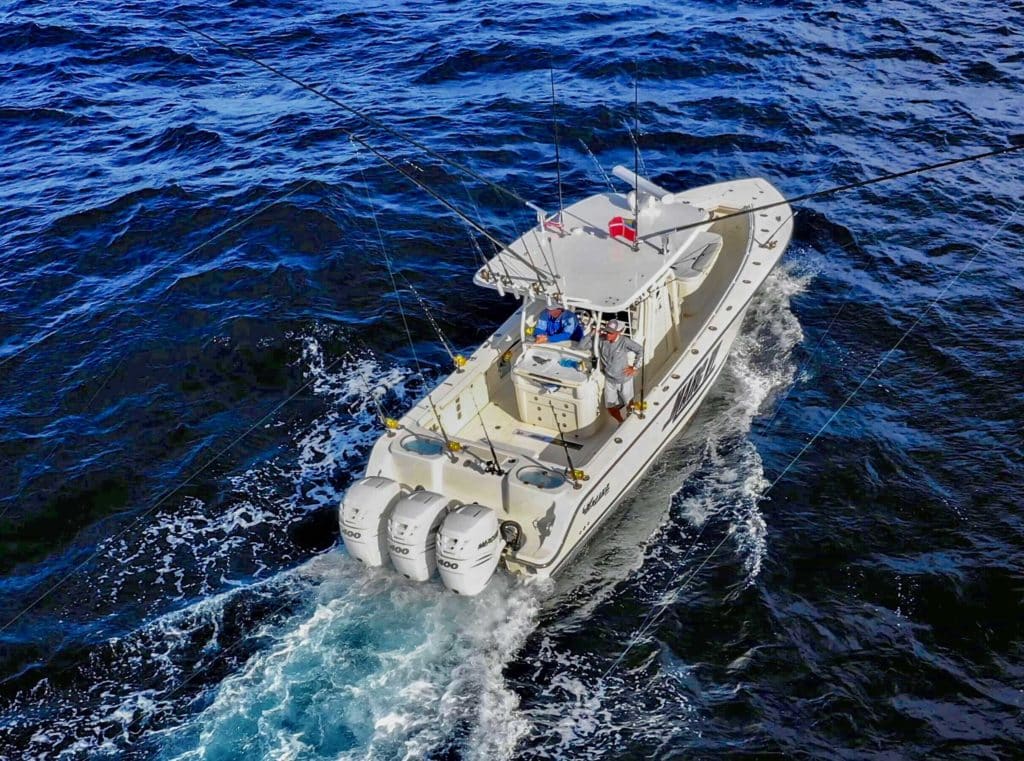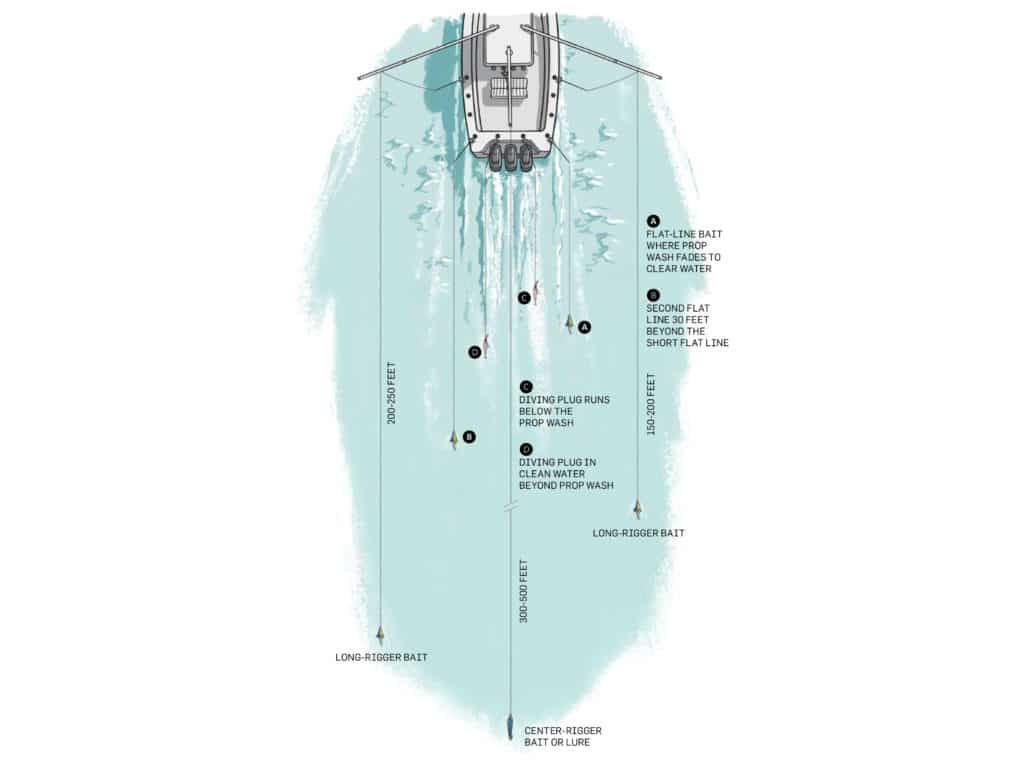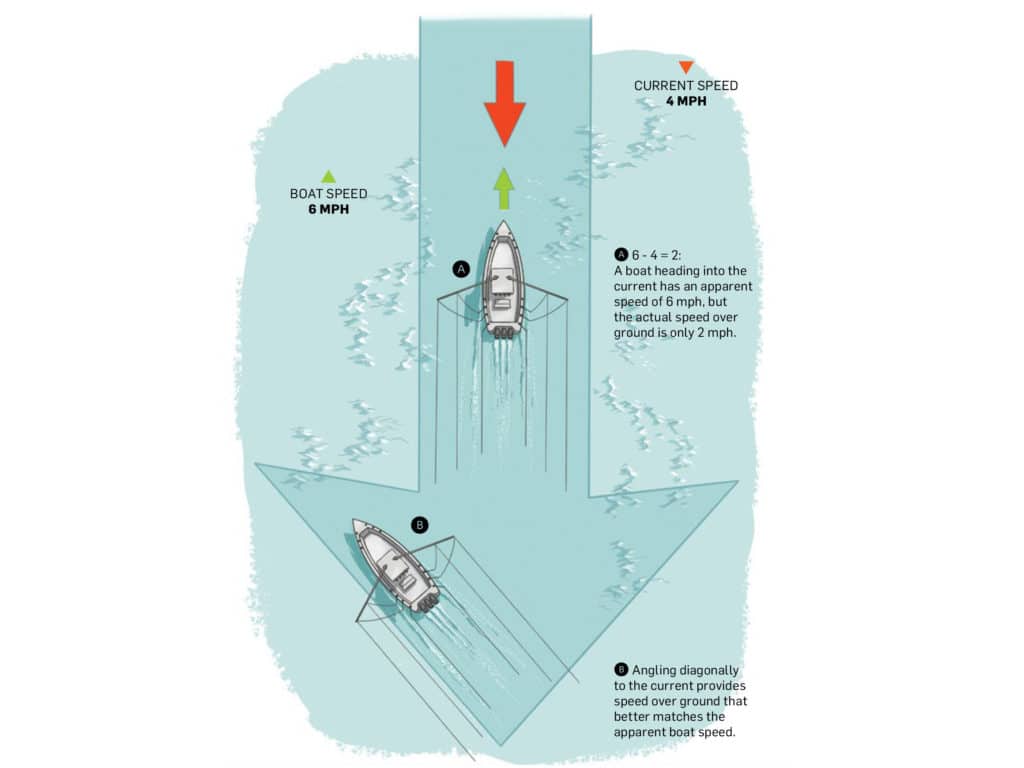
There are numerous methods of targeting gamefish, and each serves as a foundation upon which to build success. However, notable achievements are usually contingent upon subtle tweaks and aggressive modifications to the fundamentals, especially when conditions turn challenging or feeding activity ceases.
For general offshore trolling, I’ve outlined five crucial parameters. These are strictly for the mechanics of offshore trolling, and not the skills required to decipher ocean environments and conditions to locate fish.
Realistic Illusions
Potent trolling spreads unleash fish-attracting surface commotion and present the illusion of forage scurrying for survival. Pelagics can be coaxed to the boat with white water splashing behind it, but absent the fleeing-prey deception, they’ll likely fade away. Holding them is an art.
I position my baits in clean water, in a staggered formation to isolate each bait for easy pickings. A pair of 20-foot carbon-fiber outriggers spread the baits—and any teasers—well off the sides of the boat, over clean water. The center-outrigger bait excluded, the long-outrigger baits are the longest lines in the spread. If short-outrigger baits are deployed, they skip or swim in clean, blue water outside the prop wash and generally behind any teasers. These baits represent the closest in the trolling spread.

Dirty water has merit, however. I believe prop wash appears as a feeding frenzy, so I position port and starboard flat lines around this agitation; one bait rides where the prop wash dissolves into clean, blue water, and the other about 20 to 40 feet beyond that.
With deep-diving swimming plugs, a Mag 40 diver runs in the wash, tracking near the bottom of the commotion, whereas a Mag 30 swims in the clean water behind the wash.
Read Next: Trolling With Swimming Plugs
As a general rule, beyond my flat lines, the long-outrigger baits run roughly 150 to 200 feet and 200 to 250 feet back, respectively. The center-outrigger bait rides approximately 300 to 500 feet beyond the spread. Sea conditions and bait types constantly dictate adjustments. Again, the conditions, targeted species (e.g., deep baits for wahoo) and style of fishing (e.g., teaser fishing) all factor here.
Speed Dial
Trolling speeds are crucial to generate strikes, and there’s no magical velocity for success. My optimal trolling speed is when the baits do exactly what they’re supposed to be doing. That is, skipping baits should barely break the surface—not greyhound across it—and swimming baits should shimmy just under the surface.
It takes some placement and throttle adjustments to achieve the right illusion. If strikes are slow in coming, experiment with trolling speeds. Picking up the pace might be the solution. It enables you to cover more territory and changes the bait action. Off-center trolling (tight zigzag patterns) also enhances bait action.
Slowing the pace also works, even when skipping baits are floundering under the surface. Slowing down to a few miles per hour has helped us score dolphin, tuna, billfish, king mackerel, and even grouper near shallow reefs.
We often employ the sink-and-swim: Shift into neutral, let the baits sink for a minute, and then quickly resume trolling speed. Remember, it’s all about presenting the illusion of fleeing forage.
Ground Cover
Trolling is search-fishing, hunting along color changes, rips, thermal edges, canyon walls, trenches, mounds and other structure. Remove the visual clues presented by rips and color changes, and the effort becomes considerably more difficult.
The trail feature on my sonar-mapping page reveals exactly where my boat is in relationship to bottom structure, how much real estate I’m covering and more.

If I had a dollar for every story I’ve heard of anglers experiencing unsuccessful dolphin trips, I’d be the owner of Salt Water Sportsman. Among trollers, the theme involves towing baits in a southerly direction for most of the day, unsuccessfully. Given that the north-flowing Gulf Stream averages 2 to 4 mph, simple math shows that little ground gets covered trolling directly into the Stream between 5 and 8 mph. Water volume is covered, but not hard bottom. Speed over ground becomes minimal. In this situation, a trail feature reveals this lack of progress in bottom coverage; conversely, deviating easterly and westerly will result in better progress over bottom and structure.
Hooking Up
Another common trolling error is slowing or shifting into neutral right after hooking up. Monofilament lines have an inherent stretch of up to 25 percent. To accommodate this stretch and increase solid hook-sets, keep the boat moving forward at the same trolling speed for at least 30 seconds. Do not gun the boat in drag-racer fashion to set hooks; it will knock folks off balance and ruin the rhythm of the bait spread. Maintaining steady, forward momentum keeps the remaining baits in play, increasing chances for multiple hookups.
Endgame
Throughout the fight, maintain just enough forward momentum to keep the angler straight to and tight with the fish (read: no slack or bellies in the line). This is particularly critical with a heavy lure or weighted bait, which the fish could shake off with any slack.
Read Next: How to Set Your Outrigger Clips
Shifting into neutral during the final stages could also be disastrous. The objective is to preserve the rhythm of the fight and keep the fish swimming toward the boat. Bump the throttles in and out of gear, holding a straight heading, and lead the fish alongside the boat.
A full standstill should only come after the catch has been released or deposited into the cooler.









